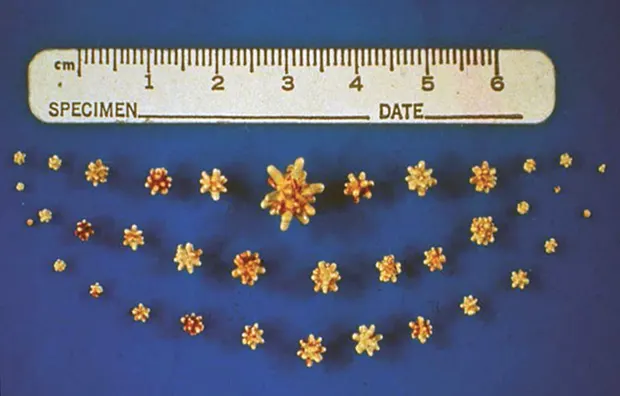Silica Urolithiasis

You have asked
How do I manage silica urolithiasis?
The expert says
Silica-containing uroliths were rst reported in the United States in 1976 as associated with an increased use of plant-derived ingredients by the pet food industry and an increased availability of crystallographic techniques for urolith analysis. Silica-containing uroliths frequently, but not always, have a jack shape (Figure 1), although not all jack-shaped stones are silicates (ammonium urate, calcium oxalate, and struvite uroliths may also be jack-shaped). Silica-containing uroliths occur infrequently in dogs. Incidence ranged from 0.4%9.6%1-6 in several large retrospective studies at urolith analysis laboratories. Many of the reported silica-containing uroliths in the United States have occurred in German shepherd dogs, shih tzus, old English sheepdogs, and golden and Labrador retrievers. Most silica-containing uroliths are diagnosed in dogs 68 years of age, and males are affected more commonly than females (>9:1 M:F).2 In most dogs, numerous silica uroliths form, versus a solitary urolith. Silica-containing uroliths are radiographically opaque compared with surrounding soft tissue (Figure 2).

Multiple silicate uroliths removed from a dog. Photo courtesy of Dr. Howard Seim
The effect of urine pH on silica solubility is largely unknown, although many silica-containing uroliths are found in acidic urine.2 Secondary UTIs may occur as a result of mucosal irritation caused by these irregular jack-shaped uroliths. Silica may also be found in conjunction with calcium oxalate and struvite-containing uroliths. As an example, jack-shaped silica-containing uroliths may irritate the bladder mucosa, altering host defense mechanisms resulting in a UTI with alkaline urine and subsequent deposition of a layer of struvite crystals on the silica nidus. It is also possible that calcium oxalate and silica may form a mixed urolith by epitaxy where the calcium oxalate and silica crystals are combined with a particular orientation throughout the urolith.

Lateral radiograph of a dog with a solitary silicate urolith.
Silica-containing uroliths are rare in cats (<0.1%0.4% of all feline uroliths analyzed), and there appears to be no age, gender, or breed predispositions.1,4,5
Pathophysiology of Silica-Containing Uroliths
The factors responsible for the pathogenesis of silica-containing uroliths are unknown, but their formation is probably related to the dietary intake of silicates, silicic acid, or magnesium silicate. Given that silica and silicate (salts of silicic acid) are extremely common in soil, plants often contain relatively high amounts of silica (eg, 1%4% dry weight). Rice hulls, an extreme example, contain 16%17% silica on a dry-weight basis. In addition to rice hulls, there appears to be a link between the formation of silica uroliths in dogs and the consumption of large amounts of corn gluten feed or soybean hulls, both of which can be high in silicates. Of note, corn gluten feed is different than corn gluten meal, which is a digestible form of protein contained in many high quality dog foods. Ingested silicic acid is readily absorbed from the GI tract and then excreted via the kidneys. In susceptible dogs, food (especially dry diets) containing a high percentage of plant-derived ingredients is a likely risk factor for silica-containing urolith formation.
Treatment & Prevention
Medical dissolution of silicate uroliths is not yet feasible. Silica-containing uroliths may be removed by voiding hydropropul-sion (if the uroliths are small enough to pass through the urethra), lithotripsy, or, most commonly, surgery. Recommendations to decrease recurrence after surgical removal include dietary change, increasing urine volume, and urine alkalization. Dietary change is prudent, especially in cases of recurrent silica urolithiasis. Diets relatively low in vegetable protein and other plant-based nutrients are recommended. Lowering dietary protein may reduce renal medullary urea concentrations and contribute to the formation of less concentrated urine.
Related Article: Nutritional Management of Urolithiasis
Additional preventive measures after surgical management include increasing urine volume and eradicating any UTIs. Lowering the urine specic gravity decreases the urinary concentration of silica. Feeding canned food helps increase water intake as will making available multiple sources of clean, fresh water. Maintenance of a urine specic gravity of less than 1.020 is ideal, and dogs should be allowed frequent opportunities to void. Urine sediment and pH should be monitored routinely, and UTIs should be treated promptly based on bacterial culture and sensitivity results. Lateral abdominal radiographs should be taken periodically, and if there are signs of a lower urinary tract inflammation, abdominal radiographs (Figure 2) help rule out urolith recurrence. Because soil contains high concentrations of silica, consumption of dirt and grass should be discouraged.
GREGORY F. GRAUER, DVM, MS, DACVIM, is professor and Jarvis chair of medicine in the department of clinical sciences at Kansas State University. He has also served as professor and section chief of small animal medicine at Colorado State University and faculty member at University of WisconsinMadison, where he completed his internship and residency and earned his MS. His area of interest, research, and teaching is the small animal urinary system. Dr. Grauer earned his DVM from Iowa State University.